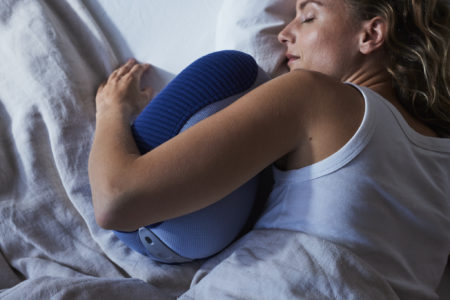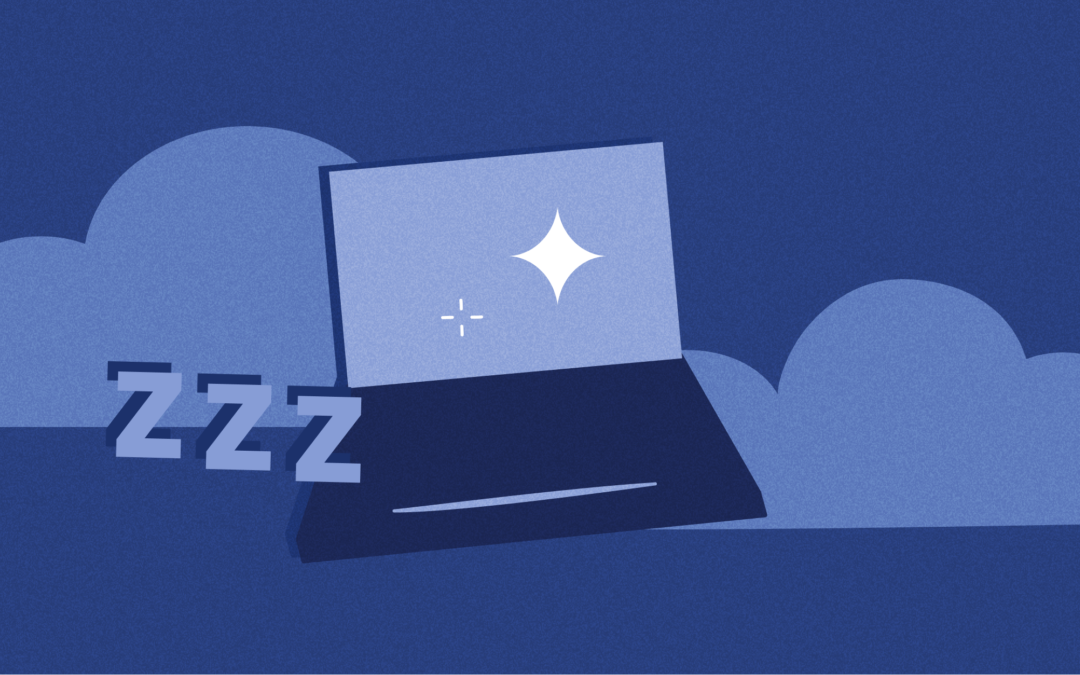
by Luciënne Lieshout | Thursday, August 18, 2022 | Breathing, Research, Sleep
Does someone need a hug? Whether you consider yourself to be a natural “hugger” or not, giving and receiving hugs can benefit both your physical and mental health.
Hugging stimulates the production of the hormone oxytocin in the body. This feel-good hormone leads to feelings of less stress and improved wellbeing.[*]
It gets even better because you don’t need to wait around for someone to hug you. You can reap the benefits of hugging all on your own. Let’s find out how.
History of Hugging
Hugging and embracing one another has always been an important part of the human experience. Most babies experience their first hug at birth when they are placed into their parent’s arms. For children, hugging and embracing are important elements in their emotional upbringing. Hugging can lead to feelings of attachment and greater self-confidence.[*]
Throughout history, hugging has been viewed as a warm greeting. It is often used as a show of affection, appreciation, or gratitude. Hugs are also typically given as a way to offer congratulations or condolences among friends. A hug tends to be viewed as a warmer greeting than a handshake. [*]
People who hug when greeting others are generally viewed as open and friendly. Research shows that people who grew up with frequent hugs are more likely to hug others as opposed to other forms of greeting, such as a handshake.[*] Most of us have had the experience of meeting someone new who immediately embraces us and declares that they are “a hugger.”
Mental Health Benefits of Hugging
Hugging is a powerful way to improve your health thanks to the hormone oxytocin. Oxytocin is a hormone that is released with therapeutic touch like hugging.[*] It is also released during childbirth, breastfeeding, and sexual activity. It’s produced in the hypothalamus (which is part of your brain and controls the autonomic nervous system) and has been linked to improved quality of life and enhanced feelings of wellbeing.[*] Oxytocin has anti-stress effects too. Here are just a few of the benefits you can expect from a hug.
Less Stress
There’s a reason why you usually feel calmer after hugging a loved one. A 2014 study of 404 healthy adults found that being hugged has a stress-buffering effect. The data suggested that hugging may effectively convey social support.[*] Even newborn babies display less stress after receiving a hug or light touch.[*]
Feel Better
Receiving a hug has a powerful effect on your quality of life. People who regularly hug those in their lives tend to experience better relationship functioning. They also report higher levels of overall wellbeing.[*]
Stronger Immune System
The benefits of hugging go far beyond mental health. A 2014 study found that when study participants received regular hugs, they were less likely to become sick. After being exposed to the common cold virus, the individuals who had been in the hugging group experienced less severe illness than those in the control group.[*]
Lower Blood Pressure
A 2003 study found that physical contact such as hugging or holding hands led to lower blood pressure and reduced heart rate. Even when study participants were asked to do something stressful such as giving a public speaking presentation, a hug still reduced their blood pressure and heart rates.[*]
Can You Hug Yourself?
The health benefits of hugging are exciting but what do you do if there’s no one around to hug? Fortunately, you can still score positive health outcomes by hugging yourself.
A 2011 study found that crossing your arms across your midline can lower painful sensations in the body. Study participants received painful stimuli and noticed that the pain felt less intense when they crossed their arms in a self-hugging position. Researchers hypothesized that this hugging position may interfere with pain signals to the brain.[*] By interrupting pain signals before they reach the brain, hugging yourself reduces pain.
To start reaping the benefits, try wrapping your arms around yourself and taking a few deep breaths. For added comfort (and deeper, more even breathing), hug the Somnox 2 Sleep Companion as you fall asleep.
You probably know how it feels to spoon someone or be spooned by someone. Somnox has been designed to be a comfortable, useful, and easy to cuddle sleep companion. Comfort is mainly ensured by the ergonomic shape of Somnox and the material used to cover it. You can hug Somnox at night like your pet – and snooze off to a better night’s rest.
Keep Hugging
The health benefits of hugging are wide-ranging and include decreased levels of stress, lower blood pressure, and a stronger immune system. You can start adding these health benefits to your life right away. Make a note to hug your loved ones more often. And don’t forget about hugging yourself or the Somnox 2 Sleep Companion to start feeling better now.
Want to find out if Somnox could be something for you? Then you should definitely take our sleep test!


by Luciënne Lieshout | Monday, August 15, 2022 | Breathing, Research, Sleep
Sleeping at work—have you done it? Thought about doing it? Know people who do it? The idea of sleeping at work seems like a comical trope, but it’s surprisingly common. Some believe sleeping at work is unprofessional and that employers should discipline employees for doing it. Others believe that napping during the day can improve productivity.
Who is right? In this post, we will explore the issue of sleeping at work. We will discuss the benefits of napping at work and things employers should consider.
Employees in these industries admit to falling asleep at work
So, who is falling asleep at work? Amerisleep, a mattress company, surveyed 1,001 workers across various industries to answer this question. They examined 12 sectors. A whopping 70% of tech workers admitted to sometimes sleeping on the job—this was the highest group.
The industry least likely to sleep at work was the arts, entertainment, and recreation. Still, 35% of workers in this industry admitted to sometimes sleeping on the job.
What does this tell us? No matter which industry you work in, it’s likely that you’ve caught yourself (or a coworker) dozing off at work. If you have, you’re not alone.
Naps during work hours improve performance
Scientific research has established that sleep deprivation causes a dip in productivity at work. It also has negative effects on health.
A study in the Journal of Sleep Research found that naps can be a part of a comprehensive alertness-management strategy. In operational settings, naps can help manage fatigue and allow workers to stay alert throughout long shifts. This promotes safety for workers who work around dangerous equipment.
But what is the optimal nap length and how long do the effects of naps last?
How long should employees nap?
One study showed that short naps (10-30 minutes) help workers feel more awake and improve performance. Long naps were associated with less productivity and sleep inertia. Sleep inertia is that groggy, disoriented feeling you get after waking up from a long nap or after getting less than six hours of sleep.
How long do the benefits of napping last?
Another study showed that the beneficial effects of short naps (5-15 minutes) have beneficial short-term effects that last around 1-3 hours. Naps longer than 30 minutes can induce sleep inertia for a while, but once feelings of drowsiness and confusion wear off, the cognitive benefits of the long nap last much longer, up to many hours.
Sleeping at work helps you regulate your emotions
Do you dread looming deadlines? What about frustration over a difference of opinions with a coworker or boss? How about just plain stressed out? If you’ve ever held a job on the planet Earth, the likelihood is high that your answer is “yes”.
Even when we enjoy our responsibilities and the people we work with, occasional negative emotions are inescapable in the workplace as they are elsewhere in life. And for some, the workplace can be rife with negative emotions.
So, what can be done to help us deal with these challenging emotions? You guessed it—napping.
Researchers at the University of Central Florida College of Medicine found that daily 20-minute naps were positively correlated with reduced stress in med students. The ability to manage stress can be paramount to your mental health and success at work.
Other researchers found that napping actually helps you evaluate other people’s emotional states by promoting better recognition of emotional facial expressions. The boost you get from napping to evaluate facial cues can certainly be helpful for navigating a team environment.
Should workplaces provide places to nap?
The blurring of the work-life boundary
The technology of the past decade allows work to contact us anytime, anywhere. As a result, the boundary between work and personal life has eroded for some. Extra work time pushes back non-work priorities that the person must take care of later and later. This pushes back bedtime and results in a loss of sleep. In other cases, some remain awake answering emails on their phones or performing other tasks when they would normally be sleeping.
The blurring of the work-life boundary and the resulting loss of sleep is not just about time management. The added stress that follows employees home after working hours takes a toll, causing sleep problems. Up to a third of all adults experience chronic insomnia. More occasional insomnia symptoms affect up to 50% of adults. No wonder so many employees have trouble staying awake!
Nap rooms in the workplace
We know that a large percentage of American workers experience sleep deprivation and sleep disorders. We also know that feeling tired leads to a loss of productivity and safety hazards. So should companies provide spaces for employees to take power naps at work?
The answer is “yes!” according to some of the largest, most innovative companies in America including Google, Uber, and Zappos. Sleep science has shown that napping leads to better health and increased productivity. So it is in a company’s best interest to provide nap rooms or sleep pods where employees could take short naps during work hours.
Of course, there are logistical questions to consider. How should a company allow a worker to nap? Should employers pay employees to nap? Does the employee have to stay later to make up the nap time?
As more and more companies put nap rooms and napping policies in place, the answers to those questions will be revealed.
Power nap with Somnox to regain your focus at work
Somnox is a Breathe & Sleep Companion that helps you relax and sleep by helping you regulate your breathing. Thousands have benefited from Somnox helping them fall and stay asleep at night.
But nighttime sleep isn’t the only thing Somnox can help with. Somnox can be used any time of day to help you unwind, calm down, meditate, or nap. The sleep companion is a 24-hour resource for self-care.
If you work from home, Somnox is easy to reach for when you’ve been chugging along since morning and feel yourself start to fade in the afternoon. Then all you need to do is cuddle up with your Somnox, draw the shades, and set an alarm for anywhere from 5 to 30 minutes. After snoozing for a short while, you should wake up refreshed and ready to refocus yourself on your work for the rest of the afternoon.
If your employer permits napping and either provides nap rooms or if you have an office door that shuts, bring your Somnox to work if you know you have a long day ahead of you and know you’ll need a nap.
It never hurts to take a moment for yourself so you awake renewed and ready for everything the rest of the day will throw your way.
In summary
Many people admit to falling asleep in the workplace. Research suggests that napping during work hours can improve performance and that it would benefit both employees and employers if companies provided napping spaces.
When napping during the workday, consider how long your nap should be so that you wake up feeling energized and not groggy. Also, consider how long the benefits will last you when planning your nap.
If you’ve found yourself nodding off at work, you may not be getting the restful sleep you need at night. Somnox is an excellent resource for those looking to fall asleep easily and quickly day or night and wake up well-rested. Take our online sleep test to determine if Somnox is right for you.
Sources
Bhaskar, S., Hemavathy, D., & Prasad, S. (2016). Prevalence of chronic insomnia in adult patients and its correlation with medical comorbidities. Journal of Family Medicine and Primary Care, 5(4), 780. https://doi.org/10.4103/2249-4863.201153
Dhand, R., & Sohal, H. (2007). Good sleep, bad sleep! The role of daytime naps in healthy adults. Current Opinion in Internal Medicine, 6(1), 91–94. https://doi.org/10.1097/01.mcp.0000245703.92311.d0
Hernandez C, Daly K, Mehta A and Verduin M. A Pilot Study Examining Biofeedback and Structured Napping to Promote Medical Student Wellbeing [version 1]. MedEdPublish 2019, 8:110 (https://doi.org/10.15694/mep.2019.000110.1)
Hyde, M. (2022, July 17). Sleeping at Work. Amerisleep. https://amerisleep.com/blog/sleeping-at-work/
Insomnia: Causes, Risks & Treatments. (2020, October 15). Cleveland Clinic. Retrieved August 4, 2022, from https://my.clevelandclinic.org/health/diseases/12119-insomnia#:%7E:text=They%20affect%20up%20to%2070,at%2010%25%20to%2015%25
Lovato, N., & Leon, L. (2010). The effects of napping on cognitive functioning. Progress in Brain Research, 185, 155–166. B978-0-444-53702-7.00009-9 https://doi.org/10.1016/
Ninad Gujar, Steven Andrew McDonald, Masaki Nishida, Matthew P. Walker, A Role for REM Sleep in Recalibrating the Sensitivity of the Human Brain to Specific Emotions, Cerebral Cortex, Volume 21, Issue 1, January 2011, Pages 115–123, https://doi.org/10.1093/cercor/bhq064
ROSEKIND, M. R., SMITH, R. M., MILLER, D. L., CO, E. L., GREGORY, K. B., WEBBON, L. L., GANDER, P. H., & LEBACQZ, J. V. (1995). Alertness management: strategic naps in operational settings. Journal of Sleep Research, 4, 62–66. https://doi.org/10.1111/j.1365-2869.1995.tb00229.x
Takahashi, M. Prioritizing sleep for healthy work schedules. J Physiol Anthropol 31, 6 (2012). https://doi.org/10.1186/1880-6805-31-6
7 U.S. Census Bureau. (2021, October 8). Using Administrative Data, Census Bureau Can Now Track the Rise in Multiple Jobholders. United States Census Bureau. https://www.census.gov/library/stories/2021/02/new-way-to-measure-how-many-americans-work-more-than-one-job.html
Wilkie, D. (2021, July 6). Asleep on the Job: When to Discipline, When to Accommodate. SHRM. https://www.shrm.org/resourcesandtools/hr-topics/employee-relations/pages/sleeping-on-the-job.aspx

by Luciënne Lieshout | Friday, July 8, 2022 | Breathing, Research
If you’ve been thinking about beginning meditating—or you’ve tried meditation before but weren’t sure if it did anything for you—then this blog post is for you. Read on to learn how to begin a solid meditation practice.
Who should meditate?
Whether you consider yourself a nervous wreck or a total zen master, you can benefit from meditation. When practiced over time, meditation can actually change your brain for the better.
Meditation can be tremendously beneficial for mental conditions like depression and anxiety. It can also help manage physical conditions like chronic pain. But it’s also just an excellent tool for managing everyday stress. So unless you live a life free from problems, meditation is for you!
What is the goal of meditation?
The goal of meditation is to achieve a state of tranquility. This is a state where your thoughts can exist without judgment. Emotions are the result of the way we judge our thoughts. These emotions, when negative, can lead to restlessness or stress.
By accepting your thoughts as they are, you can ease feelings of restlessness, anxiety, and stress.
The role of the breath in meditation
Breathing is the crux of meditation. By consciously working on calm breathing, tension melts away from your body. Somnox can help you work on your breathing. All you need to do is put your hands on Somnox (or hold it close to you) to follow its breathing. Through the Somnox app, you can fully customize your breathing experience.
5 steps to start meditating
1. Make time for meditation
It is often difficult to find time for meditation. “I don’t have time” becomes an easy excuse to skip sessions or to never start in the first place. That’s why it’s important to plan in advance when you will meditate and for how long. Ten minutes is all you need to start!
By putting meditation on your schedule and making an appointment with yourself, it is often easier to stick to it. If you don’t like to plan ahead or don’t think you can commit to sticking to a plan—don’t let that stop you. You can always meditate as needed when you experience stress or negative emotions.
2. Find a comfortable position
Choose a position that feels comfortable to you. Here are some common positions people take when meditating.
- Sit in a chair
- Sit on the floor with legs crossed
- Sit on a cushion on the floor
- Sit against a wall with your legs straight
- Sit on your heels with knees bent
- Lying down*
*Although it’s usually recommended that you meditate while sitting up so you can remain alert, if this is too difficult for you or you’re not feeling well, you can meditate lying down. Just make sure you can stay alert in this position.
Once you’ve found your ideal meditation position, relax your body and rest your hands on your Somnox so you can feel it breathing.
3. Breathe with Somnox
Breathing is central to meditation. The breath acts both as a focal point for the mind and is also used to calm the body. By concentrating on the rhythm of your breathing, you have a place to return to again and again when your mind wanders.
By actively breathing with Somnox, you are consciously slowing down your breath, relaxing your body and mind. Focus your attention on the flow of air in and out and your belly rising and falling. If you want to learn more about how Somnox works, click here!
4. Let your thoughts move through you
If you’ve ever tried meditating before, you may have been asked to “clear your mind.” Unless you’re a master meditator, achieving a clear mind for an entire meditation session is nearly impossible. Thoughts will pop up as you focus on your breath. Don’t let these thoughts discourage you from meditating—this is part of the process.
Allow these thoughts to move through you without judging them. If you experience a distracting thought or feeling, acknowledge it, but don’t give it power by dwelling on it. Simply return your focus to the breath. Each time your mind strays, acknowledge your thought or feeling, then return to the breath again and again. This is how you practice meditation.
5. Practice!
Although you will feel peaceful after meditating, it can seem a bit challenging at first. But the more you do it, the easier it will become, and the more you’ll benefit from it. So grab your Somnox, get into a comfortable position, and start meditating today!
Still not sure if Somnox is for you? Take the sleep test to find out!
Sources
Dixon, T. (2017, August 20). Key Studies: The effects of mindfulness and meditation on the brain (Desbordes et al. 2012, and Lazar et al. 2005). IB Psychology. https://www.themantic-education.com/ibpsych/2017/08/21/key-studies-the-effects-of-mindfulness-and-meditation-on-the-brain-desbordes-et-al-2012-and-lazar-et-al-2005/
Powell, A. (2018, August 27). Harvard researchers study how mindfulness may change the brain in depressed patients. Harvard Gazette. https://news.harvard.edu/gazette/story/2018/04/harvard-researchers-study-how-mindfulness-may-change-the-brain-in-depressed-patients/

by Luciënne Lieshout | Monday, June 20, 2022 | Breathing, Research
The summer solstice is just around the corner and with it comes hot, sticky nights. Many people find it difficult to get a good night’s sleep during the summer months. Luckily, we’ve got some tips and tricks to help you stay cool and get a good night’s sleep. Keep reading to learn how to sleep when it’s hot!
Is Samantha’s story familiar?
Samantha loves summertime but she doesn’t love summer nights. It gets really humid where she lives, so it stays warm even when the sun has gone to bed. Even though she only sleeps with a light sheet, she finds herself tossing and turning, taking her much longer to get to bed than usual.
She doesn’t want to spend a fortune on air conditioning, so she opens the windows and turns on her ceiling fan, and even brings an extra fan into her room. But she still can’t seem to get cool!
Sound familiar? So what’s the deal—why is it harder for us to sleep during warm summer nights?
Why do we sleep worse when it’s hot?
There are a few reasons why hot weather can make it difficult to sleep. First, long summer days and exposure to light later in the day mean our bodies begin producing melatonin later. Melatonin is the hormone that makes us feel sleepy, so when it’s produced later in the day, we can have trouble falling asleep.
Another reason hot weather can cause us to sleep worse is due to body temperature. Humans and other mammals usually have a lower core body temperature right before and during sleep. These changes in body temperature are actually regulated by our circadian rhythm. Our circadian rhythm controls our internal clock which regulates our sleep/wake cycle. So when it’s hot at night, our bodies have a harder time regulating their temperature.
Okay, so how do I stay cool at night?
There are a few things you can do to lower your body temperature and make it easier to sleep during hot weather.
1) Close your blinds or curtains while the sun is out
Make sure to keep your blinds shut during the day. This will help to keep your room cooler—and you more comfortable—when the sun goes down. If you have blackout curtains, even better! These will block out all light and have insulative properties to further block heat from your bedroom.
2) Control the temperature with fans or evaporative coolers
If you’re not looking to spend a fortune this summer on your energy bill cranking your AC, you can get creative with fans and evaporative coolers. An evaporative cooler (aka swamp cooler) is a very affordable option for cooling a small space. You can buy a portable unit that doesn’t cost much and doesn’t use much electricity. This should help keep the temperature down in your room. You can also turn your ceiling fan on so that it circulates counterclockwise for a wind-chill effect.
3) Assess your bedding situation
Hopefully, you’ve remembered to put your fleece and heavy down comforters away and changed over to summer fabrics. Cotton and linen are affordable options while silk is cooling and helps regulate body temperature. If you don’t have light bedding, now’s the time to invest. You might also want to consider a cooling mattress topper or cooling pillow to help you sleep when it’s hot.
4) Eat light, small meals in the evening
Meals that are heavy in carbs and fats can make you feel sluggish and can cause indigestion, making it harder to sleep. They also take more energy to digest, so this can cause your body to heat up. Spices are also best avoided in the evening as they can cause nighttime hot flashes. Instead, focus on lean proteins and vegetables.
5) Relax your body with the help of Somnox
Summer heat can keep your body feeling uncomfortable when you’re trying to sleep. But stress and anxiety are the main culprits behind sleeplessness. If you can find a way to relax your body and mind before bedtime, you’ll be well on your way to enjoying deep and restful sleep.
That’s where Somnox can help. Your Somnox sleep companion offers a sense of security while relaxing you through the automatic slowing of your breath. You’ll forget the heat and drift off to sleep in no time!
In Conclusion
While we can’t change the weather, there are plenty of things we can do to make our summers more comfortable. From cooling down our bedrooms with fans and evaporative coolers to eating lighter meals in the evening, these tips should help you beat the heat this summer.
And if you still find yourself struggling to get a good night’s sleep, consider investing in a Somnox. This unique sleep companion helps relax your body and mind so that you can drift off faster and easier. So what are you waiting for? Take our quiz to see if Somnox is right for you!
Sources
Neustein, M. R. B. S., MD, & Okoye, W. B. A. (2021, November 12). Why Do You Get Hot When You Sleep? Sleep.Org. https://www.sleep.org/how-sleep-works/does-your-body-temperature-change-while-you-sleep/
Sievers, M. (2021, June 30). How to Stay Cool at Night: 25 Tips. Casper Blog. https://casper.com/blog/how-to-stay-cool-at-night/
Vondrasová D, Hájek I, Illnerová H. Exposure to long summer days affects the human melatonin and cortisol rhythms. Brain Res. 1997 Jun 6;759(1):166-70. doi: 10.1016/s0006-8993(97)00358-2. PMID: 9219878.





Recent Comments